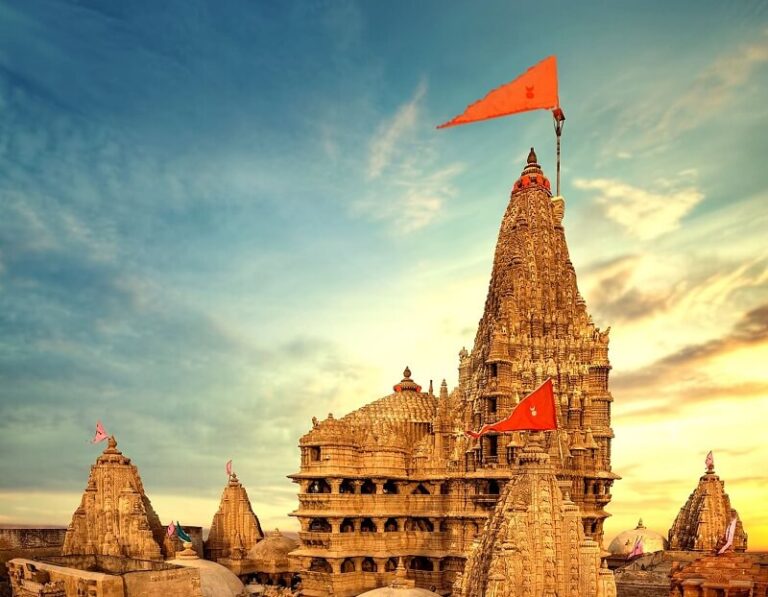The Dwarkadhish Temple: A majestic abode of Lord Krishna

Located in the enchanting town of Dwarka in Gujarat, the Dwarkadhish temple, also known as the Jagat Mandir, is a divine abode said to have been founded over 2,500 years ago by Vajranabh, the great-grandson of Lord Krishna. Situated at the confluence of the Gomti River and the Arabian Sea, the temple has great significance as one of the Char Dham pilgrimages and is a popular destination for devotees of Lord Krishna.
Delve into the Legends of Ancient Dwarka
Dwarka, historically considered the capital of Lord Krishna, occupies an important place in Hindu mythology. While the ancient city was submerged by the sea, the temples of Dwarkadhish remain intact. Part of India’s Sapta Puris, Dwarka is considered the original home of Lord Krishna, and the Pandavas are said to have spent their childhood playing on this sacred land.
The Dwarkadhish temple is a symbol of architectural brilliance and religious devotion, attracting countless visitors from all over the country. Protected by the Archaeological Survey of India, the temple is also a key site for religious tourism in India. Archaeological excavations at Dwarka have unearthed a treasure trove artifacts, including copper coins, stone blocks, pillars and pottery samples. These discoveries testify to the existence of a well-established town dating back to the 2nd millennium.
A marvel of architectural splendor
Climbing the 50-odd steps to the temple, devotees are greeted by the impressive Dwarkadhish temple. Its heavily carved walls envelop the sanctuary, which houses the main idol of Lord Krishna. Adorned with meticulously carved mythical figures and legends, the temple’s limestone structure is remarkably well preserved. The 43-meter-high spire, crowned by a flag made of 52 meters of fabric, sways gently in the sea breeze, representing the eternal presence of Lord Krishna.The Dwarkadhish temple features two gates, each endowed with profound symbolism. The Swarg Dwar, or Gate of Heaven, leads devotees up 50 steps to the Gomti River, offering a path of spiritual purification. On the other hand, the Moksha Dwar, or Gate of Salvation, links the temple to the main market and carries the essence of Lord Krishna’s teachings from the Bhagavad Gita, emphasizing the quest for spiritual liberation.
Devotion and festivities
A visit to the Dwarkadhish temple between November and February is an ideal opportunity to experience the serene atmosphere and grand celebrations of Janmashtami, the anniversary of Lord Krishna’s birth. This joyous occasion is celebrated with great fervor, attracting devotees from far and wide to join in the divine festivities.Standing as a testament to the divine presence of Lord Krishna and the captivating history of Dwarka, the Dwarkadhish temple is an mesmerizing pilgrimage site and architectural marvel. With its timeless origins, intricate craftsmanship and profound spiritual significance, this sacred abode captivates the hearts and souls of countless devotees.
